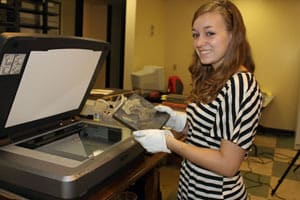Digitizing the Teitelman Collection of American Sunday-School Union Woodblocks and Imprints: A Pilot Project in Summer 2011
 This past summer, we completed a pilot project to catalog and digitize a sample of the woodblocks that came to the Library Company from the estate of S. Robert Teitelman. The Teitelman Collection of American Sunday-School Union Woodblocks and Imprints contains some 6,500 woodblocks. Based in Philadelphia, the Union was the largest publisher of children’s books in 19th-century America. Their mission was to fill all the reading needs of the American child, and the millions of small, attractively illustrated books they published did indeed contribute to the intellectual and moral development of generations of American children.
This past summer, we completed a pilot project to catalog and digitize a sample of the woodblocks that came to the Library Company from the estate of S. Robert Teitelman. The Teitelman Collection of American Sunday-School Union Woodblocks and Imprints contains some 6,500 woodblocks. Based in Philadelphia, the Union was the largest publisher of children’s books in 19th-century America. Their mission was to fill all the reading needs of the American child, and the millions of small, attractively illustrated books they published did indeed contribute to the intellectual and moral development of generations of American children.
The Union produced the majority of the illustrations in these books with woodblocks crafted by skilled artist/engravers such as George Gilbert (fl. 1818-1836), Alexander Anderson (1775-1870), John Warner Barber (1798-1885), and James Barton Longacre (1794-1869). The woodblocks represented a substantial investment, and not surprisingly the Union numbered them and stored them for reuse. By the time the main office in Philadelphia closed in the 1960s, they had amassed an immense collection, which Mr. Teitelman had the vision to acquire en masse, together with a proofbook.
When we designed the pilot project, we anticipated creating about 100 records in our online graphics catalog ImPAC to alert scholars to the research potential of the collection, especially for the study of early American pedagogy and book illustration. We are pleased to report that Elizabeth Crooks (Haverford 2012) created almost 300 records, many of which can now be viewed next to a scan of a page on which the printed illustration appears.
Thanks to funding from the John B. Hurford ’60 Humanities Center at Haverford College, the Library Company has been able to undertake summer projects such as this for many years. But this year, we expected the task to be especially challenging. The intern would need to learn so many things just to get started: how to scan according to Library Company specifications; how to use Photoshop to make the scans easier to view; how to use DigiTool (our digital assets management software), and how to do basic cataloging. However, Liz rapidly became proficient in every aspect of the project and, with intelligence and flair, created a new section of ImPAC which has rapidly become a favorite among our book-historian fans. In the near future, we will be able to build on Liz’s amazing progress by digitizing the proofbook, and using its images to accompany more scans of the woodblocks.

Leave a Reply
Want to join the discussion?Feel free to contribute!